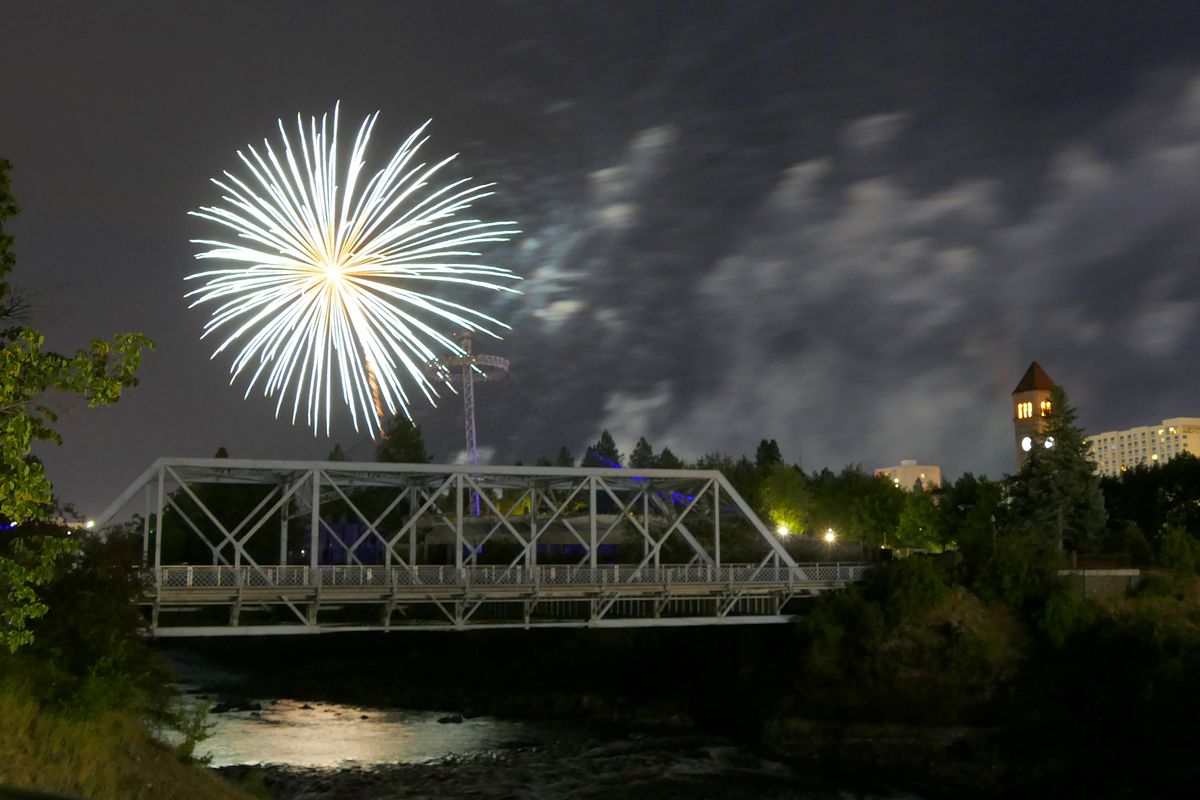First Fourth of July in Spokane

Spokane’s Fourth of July celebration this year will attract thousands to Riverfront Park. But it won’t attract 100% of the city’s residents like the first official celebration did in 1876.
In those days there were no railroads or telephones in the city. There were no brick buildings or churches. No newspapers. There wasn’t even a bridge crossing the Spokane River yet and the territory of Washington was still 13 years away from becoming a state. The record of the first celebration comes mainly from news articles written in the early 1900’s, when local reporters set out to interview those who remembered the early days in Spokane.
At the time of America’s Centennial, Spokane was a burgeoning settlement of eight to 10 cabins nestled near Spokane Falls. There was one store in town, consisting of two stories, just a couple blocks from the falls. The first Independence Day celebration came to be thanks to the store owners, the “Father of Spokane” James Glover, and his associate Cyrus Yeaton.
All 35 families who had settled in the area at that time attended the community barbecue, parade and dance held on the second floor of the store. The celebration also attracted visitors from the Pine Grove and Colville valley settlements, and members of neighboring indigenous tribes who often traded at the store.
According to many of those who attended, the highlight of the celebration was professor Ferdinand Roos, who was regarded as one of the best violin players in the Northwest. He lived on a little farm near the present-day town of Palouse, and Glover and Yeaton managed to persuade him to make the journey to Spokane “knowing that his music would tickle the heels of all the settlers,” as the Spokane Daily Chronicle put it in 1927.
In a 1927 interview with the paper, Roos recalled being tasked with forming a band for the parade. Just when he thought he would have to make do as a one-man band, Joe Davenport, father of political cartoonist Homer Davenport, came to the rescue. Davenport entered the store, emptied a keg of nails, fashioned a drum with shoulder strings and whittled a few drum sticks. The duo were then joined by a man from Colville who used a large coffee mill to grind out an accompanying tune, and a Spokane man who carried the U.S. flag. The newly formed band led a procession of about 300 people around the settlement for the area’s first Fourth of July parade.
Following the parade, settlers gathered at the community center, a clearing underneath huge pine trees, near the present-day intersection of Howard Street and Spokane Falls Boulevard. Long tables were laid out, and a whole steer was roasted by Frederick Post, the namesake of Post Falls.
Roos said the dance that evening carried into the wee hours of the morning, as couples danced the varsovienne and the quadrille to the tune of his violin.
Settler D.L. Masterson, who traveled to the celebration via horse and carriage with his parents from their ranch near Trent, told the Chronicle in 1926 that the celebration was one of his first memories. Only four years old at the time, he said he vividly remembered their passage across the river in a canoe.
Masterson told the paper that an Indigenous guide piloted a dugout canoe across the running river, with he, his parents and other visitors aboard.
“The trip across the river was epochal in my life,” Masterson said. “We were in plain sight of the boiling falls and as we were swept toward the roaring precipice, I felt in a childish way that I was doomed. However, we made shore safely and shortly joined the throng, which had gathered from miles around to participate in the ceremonies.”
A “safe and sane” Fourth of July
Masterson reported having faint memories of a fireworks display that evening. If fireworks were launched, they were not the same as the ones used today. Jim Kershner, longtime columnist and resident historian at The Spokesman-Review, said the idea of a “safe and sane” Fourth of July did not arise until the early 1900s.
“Way back in the early days, fireworks were dangerous and there were a lot of accidents,” Kershner said. “That’s really what prompted the safe and sane movement.”
The early history of fireworks in Spokane is of one accident after another. Year after year, children lost fingers to firecrackers, bystanders wound up hospitalized from errant rockets and buildings burned to the ground. Kershner has written about it all over the years, based on records from the first newspapers established in Spokane.
Kershner recalled how in 1898, a group of small boys were seen lighting firecrackers around the grandstand of Spokane’s baseball stadium at Natatorium Park. The ballpark was nothing more than a pile of smoldering ashes just a few hours later.
Sometimes the injuries were horrific, like the 1889 accident in Rockford, Kershner said. Dayton Connell, 22, died after a large rocket changed course before erupting, and struck him in the neck, and “nearly burned his head from his shoulders,” according to The Spokane Falls Review.
The fireworks of yester-year were bigger and were more accessible, Kershner said. It took decades of injuries, accidents and public debate before restrictions and regulations made fireworks safer.
Public displays like the ones taking place across the Inland Northwest this year have established a safer alternative to letting young boys run wild with 12 inch firecrackers. In Spokane, Natatorium Park was the setting for a large fireworks display for the first half of the 20th century, and the display was moved to its present-day location in Riverfront Park after the Natatorium closed in the 1960’s.